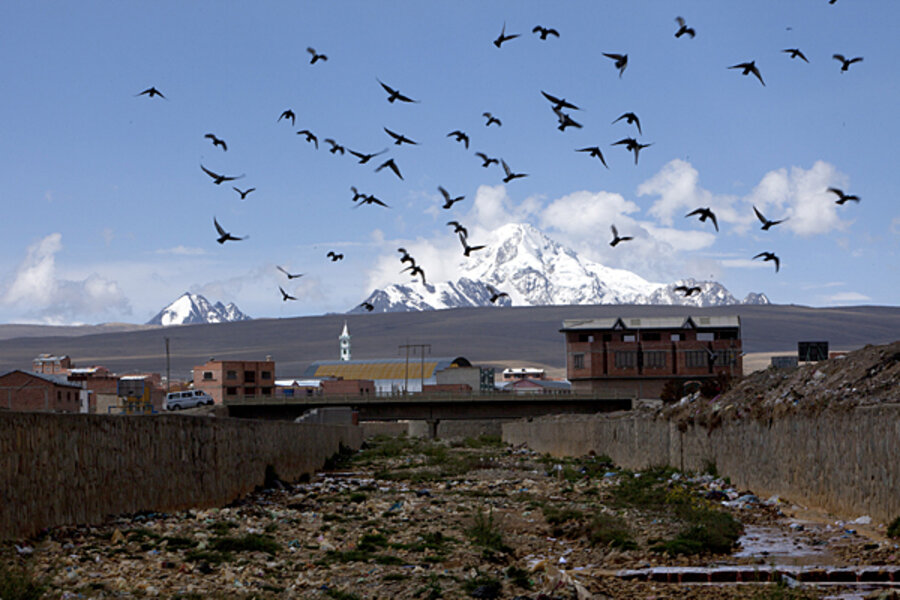Pollution threatens South America's Lake Titicaca
Loading...
| El Alto, Bolivia
Lake Titicaca glows like a sapphire amidst the subtle shades of brown on the high Andean planes. It sits on the border of Peru and Bolivia, and the Inca considered the 3,200-square-mile lake the birthplace of mankind. The waters continue to support thousands of indigenous farmers and fishermen today.
But as cities in Titicaca's watershed experience a sharp population increase, water contamination from growing urbanization becomes more acute, endangering the lake and those who depend on it.
Rivers of orange and red
The rapidly growing city of El Alto, Bolivia, is home to more than 1 million people, mostly low-income Aymara Indians from the countryside who migrate, seeking employment and education. As unplanned neighborhoods spread outward, the largest city in the Titicaca watershed struggles to provide basic services.
About 80 percent of homes in El Alto have access to potable water, but just 50 percent of its businesses and homes are connected to sewers that lead to the city's one wastewater treatment plant. The rest of the wastewater is piped directly into rivers, increasing health risks in a country of 10 million where around 30,000 children die each year from diarrhea due in part to inadequate sewers and sanitation.
Improving sewage treatment is often pushed aside due to inadequate budgets, says El Alto Mayor Edgar Pataña Ticona, and environmental laws are rarely enforced. “We have rules. They aren’t very strong, but we have them,” Mr. Pataña says.
A lack of quality sewage treatment in El Alto, as in many parts of Bolivia, means industrial waste also feeds into rivers. In sharp contrast to the deep blue of Lake Titicaca, opaque, foul-smelling water trickles through rivers in El Alto. Those rivers run red with blood from slaughterhouses, green with chemicals from factories, and vivid orange from mineral processing. Dead dogs and trash litter the banks, and are swept toward the lake when the rains come each year.
“El Alto doesn’t have an industrial park,” Marco Ribera Arismendi of The Environmental Defense League in Bolivia says. “Most of the medium and small businesses are dispersed through the city and plastic, paint, detergents, and metals from factories go into the rivers and then the lake.” A 2011 United Nations report found “alarming” concentrations of cadmium, arsenic, and lead in various parts of the lake.
There is a proposed second wastewater treatment plant for El Alto, which would rely largely on international funds for completion. But that addition alone will not be enough to allow the city to deal with all its wastewater.
Living downstream
Titicaca is big – larger than the state of Delaware – which makes it resilient and means the majority of its water is still clean. But for populations that live along polluted rivers and lakeshore areas, inaccessible clean water matters little.
People downstream from El Alto say their attempts to fight back have not yielded major change. In 2004 the Bolivian government passed a law declaring the Pallina River, one in a string of rivers that connects El Alto to the lake, an environmental disaster zone. But little action followed the passage of the law, so locals blocked a key highway leading toward the Bolivian capital of La Paz. The roadblock raised national awareness of the river at the time, but years later the water of the Pallina still runs dark and foamy.
“When I was a child the Pallina River was clean, the water was crystalline,” says Rigoberto Rios Miranda, an Aymara farmer who has lived on the bank of the Pallina his entire life. “About 15 or 20 years back they contaminated it. There were fish here – then one day waters came – I don’t know from where, maybe a tannery, but all the fish were dead.”
Mr. Rios Miranda, like many farmers, is digging wells on his property after deciding livestock should no longer drink from the river. Another economic blow for people along the Pallina is that they can no longer process tunta, a dried potato that was washed in the river water and sold for relatively high prices.
Challenged by tourism
Despite all the pollutants El Alto sends toward Lake Titicaca, it is not the only source of contamination. Rivers winding toward the lake pass smaller towns that contribute human and industrial waste, and some gold mining operations in Peru use a smelting process which releases mercury into the water. Livestock grazing along the shore loads the lake with organic waste, as well. This can fuel explosive aquatic plant growth, sucking up oxygen and cutting off sunlight other plants and animals need to survive.
Tourism is yet another concern: a double-edged sword that brings better income to the impoverished region, but also environmental challenges. The Peruvian city of Puno and Copacabana in Bolivia receive tens of thousands of national and international visitors each year.
Eco-tourism and infrastructure must be developed carefully to avoid further damaging the lake, says ecologist Francisco Fonturbel, who has studied the lake extensively. Government and non-governmental projects aim to address this issue, but much work remains. In Puno, Peru, for example, the city relies on overtaxed sewage treatment pools, and trash and raw sewage, exacerbated by sharp population influxes due to tourism, find their way into the lake.
“Right now we can see that the number of fish is decreasing,” says Marcelino Coila Choque, an Aymara fisherman who lives a few miles from Puno. He says overfishing and pollution are killing his livelihood.
“What will happen to our children in the future when the fish disappear? What will become of them?” Mr. Coila says. “That’s what we worry about … and not just here, but in different places all around the lake.”
• Reporting this story was funded by a grant from the Pulitzer Center on Crisis Reporting
Get daily or weekly updates from CSMonitor.com delivered to your inbox. Sign up today.





